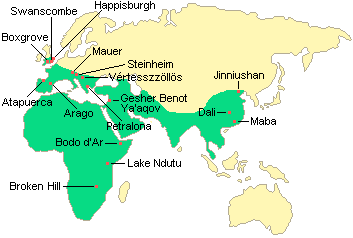Homo heidelbergensis
|
|
 |
|
|
Homo
heidelbergensis |
(skin color and location of hair
are only guesses by the artist,
but the body shape is based
on skeletal remains)
|
The evolutionary
dividing line between Homo erectus
 and modern humans was not sharp. It extended over several hundred
thousand years during the middle of the Pleistocene Epoch. Adding to the confusion about this important
transitional period is the fact that some regions were ahead of others in
the process of evolving into our species. The evolutionary changes
above the neck that would lead to modern humans may have begun in Southern
Europe and East Africa 800,000-700,000 years ago. Elsewhere in the Old
World, this change apparently began around 400,000 years ago
or later. The transition to
our species, Homo sapiens
and modern humans was not sharp. It extended over several hundred
thousand years during the middle of the Pleistocene Epoch. Adding to the confusion about this important
transitional period is the fact that some regions were ahead of others in
the process of evolving into our species. The evolutionary changes
above the neck that would lead to modern humans may have begun in Southern
Europe and East Africa 800,000-700,000 years ago. Elsewhere in the Old
World, this change apparently began around 400,000 years ago
or later. The transition to
our species, Homo sapiens
 , was not complete until around
100,000 years ago and even later in some regions.
, was not complete until around
100,000 years ago and even later in some regions.
It is
difficult to speak of our ancestors in terms of specific species during this
long period of accelerated change from 800,000 to
100,000 years ago. The more biologically progressive
post-800,000 B.P. populations in Europe and Africa
are commonly classified as a distinct
species--Homo heidelbergensis
 .
By 300,000 years ago, some of these populations had begun the evolutionary transition that would end up with
Neandertals
.
By 300,000 years ago, some of these populations had begun the evolutionary transition that would end up with
Neandertals
 and other archaic humans
(also called
archaic Homo sapiens
and other archaic humans
(also called
archaic Homo sapiens
 and premodern humans). By 100,000
years ago, some populations had evolved into
modern humans.
Others
remained largely unchanged until about 28,000 years ago, when they became
extinct. These were the Neandertals. Complicating the
picture is the fact that, in at least one area of Indonesia, a few
Homo erectus remained until at least 53,000 years ago, and the little understood dwarf
Homo floresienses persisted until at least 18,000 years ago.
and premodern humans). By 100,000
years ago, some populations had evolved into
modern humans.
Others
remained largely unchanged until about 28,000 years ago, when they became
extinct. These were the Neandertals. Complicating the
picture is the fact that, in at least one area of Indonesia, a few
Homo erectus remained until at least 53,000 years ago, and the little understood dwarf
Homo floresienses persisted until at least 18,000 years ago.
| |
 |
| |
Homo
heidelbergensis
(Petralona Cave, Greece) |
| |
|
Homo heidelbergensis was named
for a jaw of this species discovered near the town of Mauer, southeast of
Heidelberg, Germany in 1907. Since then, fossils of Homo
heidelbergensis have been
found throughout the Old World
from tropical to temperate zones.
These widespread populations show regional variations in physical appearance.
The extent of the interaction between these diverse and widely distributed
populations is not clear. Likewise, there is not yet agreement as to
which of these populations were the ancestors of modern humans. However,
it is apparent that in all regions, these people were anatomically a mosaic of
late Homo erectus and more modern human traits.
The bodies of
heidelbergensis in Europe tended to be compact, as would be expected for
people living in cold climates. This shape reduces the loss of heat.
Male heidelbergensis averaged about 5 feet 9 inches tall (175 cm) and
136 pounds (62 kg). Females averaged 5 feet 2 inches tall (157 cm) and
112 pounds (51 kg). This is only slightly smaller than most people
today. With an average of 1200
cm.3,
heidelbergensis brains were only 10% smaller than people today
as well, but their heads did not have a
modern appearance. They had large brow ridges and low foreheads.
Their brain cases also were more elongated from front to back than in Homo sapiens. In these characteristics, heidelbergensis
was still more like Homo erectus than us.
|
Important
Homo heidelbergensis Sites |
 |
| |
Date of Fossil
(years
ago) |
Cranial Capacity
( in cm.3) |
|
|
|
|
Africa: |
|
Bodo d'Ar |
600,000
|
1300
|
| Broken Hill
(Kabwe) |
700,000-400,000? |
1280 |
| Lake Ndutu |
400,000-250,000? |
1100 |
| Israel: |
|
Gesher Benot Ya'aqov |
790,000 |
|
|
Europe: |
|
Arago Cave |
450,000 |
1150 |
|
Atapuerca |
800,000-400,000 |
1125-1390 |
| Boxgrove |
524,000-478,000 |
|
|
Ehringsdorf |
245-190,000 |
1450 |
|
Happisburgh |
780,000 |
|
|
Mauer |
500,000 |
|
|
Petralona Cave |
400,000-250,000 |
1230 |
|
Steinheim |
400,000-300,000 |
1100 |
|
Swanscombe |
400,000 |
1325? |
|
Vértesszöllös |
475,000-250,000 |
1400? |
|
China: |
|
Dali |
200,000-100,000 |
1120 |
|
Jinniushan |
280,000 |
1260 |
|
Maba |
169,000-129,000 |
|
|
|
|
Note: There is not a general agreement at this time as to how
all
Homo heidelbergensis fossils should be classified.
Some paleoanthropologists prefer to classify the more recent
ones as archaic humans. Likewise, some of the earliest Homo
heidelbergensis are classified as Homo antecessor or even late transitional
Homo erectus. |
 |
|
Excavations in 2002 at the
Homo heidelbergensis site
of Arago Cave in southern
France |
NEWS:
What may be the
earliest known human footprints have been found on the slope of Roccamonfina
volcano in Italy. The three sets of footprints and a handprint surviving
in hardened volcanic ash were made 385-325,000 years ago presumably by early archaic
humans. Based on the size of the footprints, it was estimated that
they were made by someone who was not quite 5 feet tall. While these may
be the earliest known human footprints, they are not the earliest known hominin ones. That honor goes to the 3.7-3.5 million year old footprints
at the Laetoli site in
Tanzania. More information about the 385-325,000 year old Italian
footprints may be found in the March 13, 2003 issue of Nature.
NEWS:
Eudald Carboneli et al.
reported in the March 27, 2008 issue of Nature that a human jaw with
a tooth dating 1.2-1.1 million years ago has been found in Sima del Elefante
cave in the Atapuerca Mountains of Northern Spain. This is the oldest
fossil evidence of humans yet discovered in Western Europe. The
authors believe that they are from a Homo antecessor (i.e., a very early Homo
heidelbergensis or a late transitional Homo erectus).
![]() and modern humans was not sharp. It extended over several hundred
thousand years during the middle of the Pleistocene Epoch. Adding to the confusion about this important
transitional period is the fact that some regions were ahead of others in
the process of evolving into our species. The evolutionary changes
above the neck that would lead to modern humans may have begun in Southern
Europe and East Africa 800,000-700,000 years ago. Elsewhere in the Old
World, this change apparently began around 400,000 years ago
or later. The transition to
our species, Homo sapiens
and modern humans was not sharp. It extended over several hundred
thousand years during the middle of the Pleistocene Epoch. Adding to the confusion about this important
transitional period is the fact that some regions were ahead of others in
the process of evolving into our species. The evolutionary changes
above the neck that would lead to modern humans may have begun in Southern
Europe and East Africa 800,000-700,000 years ago. Elsewhere in the Old
World, this change apparently began around 400,000 years ago
or later. The transition to
our species, Homo sapiens
![]() , was not complete until around
100,000 years ago and even later in some regions.
, was not complete until around
100,000 years ago and even later in some regions.![]() .
By 300,000 years ago, some of these populations had begun the evolutionary transition that would end up with
Neandertals
.
By 300,000 years ago, some of these populations had begun the evolutionary transition that would end up with
Neandertals
![]() and other archaic humans
(also called
archaic Homo sapiens
and other archaic humans
(also called
archaic Homo sapiens
![]() and premodern humans). By 100,000
years ago, some populations had evolved into
modern humans.
Others
remained largely unchanged until about 28,000 years ago, when they became
extinct. These were the Neandertals. Complicating the
picture is the fact that, in at least one area of Indonesia, a few
Homo erectus remained until at least 53,000 years ago, and the little understood dwarf
Homo floresienses persisted until at least 18,000 years ago.
and premodern humans). By 100,000
years ago, some populations had evolved into
modern humans.
Others
remained largely unchanged until about 28,000 years ago, when they became
extinct. These were the Neandertals. Complicating the
picture is the fact that, in at least one area of Indonesia, a few
Homo erectus remained until at least 53,000 years ago, and the little understood dwarf
Homo floresienses persisted until at least 18,000 years ago.



